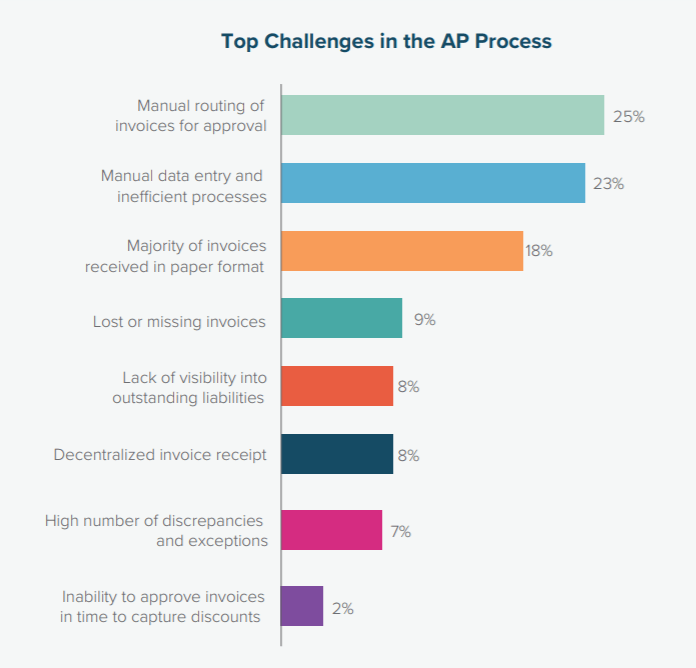Fear of change may cause as much concern among contemporary office workers as the computerized telephone systems created for manual switchboard operators. Automated pinsetters must have affected workers who set up the pins in bowling alleys similarly. Getting your workforce to embrace change can often be one of the most challenging barriers to procure-to-pay automation. Exaggerated concerns regarding automation seem to have drifted away, however, as they may soon do when you adopt procure-to-pay automation to streamline your purchase-to-pay process.
The tedious steps of selecting a vendor, issuing a requisition and a purchase order, receiving a shipment and reconciling the invoice with the order and completing the accounts payable process come into focus. Automated intelligence offers more efficient and less expensive options.
Understanding Employee Fears About Procure-to-Pay Automation
Quite naturally, employees have fears about losing their jobs, which can often be one of the biggest barriers to procure-to-pay automation. However, you can ease the transition by taking an informed approach to the implementation of change. Forbes notes that “forward-thinking employees” who embrace the transition can benefit by not fearing change. The time that the new processes save can allow employees to take on more challenging and rewarding tasks that only they can do.
According to a recent report by Levvel, manual procurement can create problems up and down the line. Accounts payable teams can have data entry errors or lost invoices, and corporate executives may not have access to an overview of the status from a management perspective.
As Deloitte points out, robotic process automation (RPA) is a new technology that can work without interruption more quickly than humans can and with lower chances of fraud or error. In a recent eBook, we explain how robotic process automation is transforming invoice processing.
You can help your teams understand that RPA can succeed because it performs “rule-based, repeatable processes” that require no “real-time creativity or judgment.” By recognizing the significant differences between their contributions and those of RPA, your team should have more understanding of their new role alongside RPA and have fewer concerns about the impact of RPA on their roles.
Listening to Concerns About Procure-to-Pay Automation
As employees reveal the basis of their issues about embracing new technology, you can plan your response to their questions and tactics for overcoming the barriers to procure-to-pay automation. Make sure to actively listen to each one and echo it back to them as an indication of your understanding.
Fear of Reduced Headcount
Employees may have a legitimate fear about reduced headcount because Deloitte confirms that “the benefits of RPA transcend headcount and cost reduction.” Since the acceptance of the new technology seems certain, you can offer your assurance that reassignments can allow the number of employees to remain the same and also sharpen their skills with the changing environment.
Perceived Dangers of Artificial Intelligence
No one needs to have control issues to worry about machines taking over. Movies have made the possibility all too real, according to LiveScience. Leading scientists and technology experts have expressed concerns about the “looming dangers” of artificial intelligence (AI). Elon Musk admits that he has concerns about it even though he has “exposure to the very cutting-edge of AI.”
Lack of Knowledge
In the absence of fact, imagination can take over and create exaggerated concerns. Unless your fellow employees spend time researching the internet for the facts about AI or RPA, you cannot fairly fault them for their lack of knowledge.
Worry about Changing Roles
The opportunity to work in a different area of a company may appeal to some employees more than others. While training may provide opportunities to learn something new, a reassignment may not offer much appeal either. The uncertainty of understanding a new role and performing well in it poses a cause for concern and can be one of the biggest barriers to procure-to-pay automation.
Overcoming the Barriers and Embracing New Opportunities
Your role as a professional who understands technology may be a bit more than others gives you an opportunity to lead. The acceptance of change usually takes time, and you help overcome some of the barriers to procure-to-pay automation by knowing how to counter the points that they raise. You may even agree with some of them, but the smooth transition to new procurement and accounts payable practices may depend to a greater or lesser degree on your understanding and leadership.
Stop Talking about Headcount
A focus on the negative aspects of anything gives energy to it and makes it harder to overcome. You cannot contribute to acceptance of automation by trying to put a positive spin on a reduction in headcount. Your best approach to conquering this particular barrier to procure-to-pay automation requires you to stop talking about it, and that helps other employees to stop focusing on it as well.
Educate Your Teams
One of the best countermeasures against resistance and fear allows fact and reason to take over. Focus on showing your teams how they can benefit from the change in technology. You can approach it by explaining that they can work on projects that have a higher value to the company instead of tedious and mundane tasks. A negotiation with a supplier requires skill and experience that only they can provide. You can follow up with training that prepares them to handle higher level responsibilities.
Elimination of Low-Value Jobs
It may surprise you to learn that some or even many of your fellow employees do not want to do the low-value jobs that they currently have in the company. Automation gives them a chance to get out from under the laborious and time-consuming tasks that occupy their day, and this positive aspect should be used as a tactic to overcome the barriers to procure-to-pay automation.
Availability of Valuable Roles
The possibility of new roles for employees gives you a good talking point with them. Until the new technology achieves a complete installation, no one can know for sure which jobs may open and need staffing. While the transition from old to new does incite fear and uncertainty at first, it also opens opportunities for a new role with your company.
AI Requires Human Intervention
Employees need to understand that automation can handle routine and repetitive tasks, but it cannot think creatively or work interactively with others. Humans must tell it what to do, creating a continuing role for employees who wonder about the security of their jobs. Once you have communicated this message successfully, you will have got the better of one of the most challenging barriers to procure-to-pay automation.
Better Overall Customer Experience
In the broader picture that reveals the company’s status as a competitor in a challenging market, it can benefit from giving customers a better overall experience. Employees who have the time to think creatively when not tied to a boring and repetitive job can contribute significantly to the company’s bottom line. Your influence as an opinion leader can help everyone.
Conclusion
Fear of change can often be brought on by a lack of knowledge. When it comes to getting your workforce to embrace procure-to-pay automation, educating your employees should be your first step. Present the opportunities that it can bring, such as more valuable roles and the new skills required while also diverting thoughts away from the negative elements. Once you have overcome the initial barriers to procure-to-pay automation, technology adoption will be much more straightforward.






